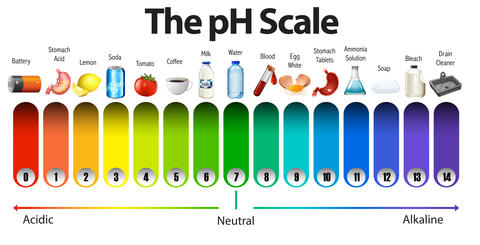Summary
The pH metrology program supports traceability for pH measurements. This traceability rests on primary pH measurements in an ideal electrochemical cell (Harned cell) and on an internationally agreed-upon convention for single-ion activity coefficient. NIST disseminates this traceability to customers through six pH Standard Reference Materials (SRMs), certified using this primary measurement. NIST pH SRMs serve as benchmarks for pH measurements in all fields of industry, government, and academia. International Key Comparisons organized by the Consultative Committee on Amount of Substance (CCQM) provide a framework for the equivalence of NIST primary pH measurements and NIST pH SRMs with corresponding measurements and reference materials of other national metrology institutes (NMIs).
Description

The suite of NIST pH SRMs forms the basis for pH measurements in the United States, and pH is the most-often-measured chemical quantity. Hence this NIST work directly or indirectly impacts a large number of users in industry, government, and academia. One of the most critical set of users is in clinical chemistry: blood pH falls within a narrow range, and low uncertainties and traceability can be crucial factors in critical patient diagnoses.
The main objectives of the pH metrology program are to provide the fundamental framework for pH measurements in the United States, to disseminate traceability via this framework to users of practical pH measurements, and to ensure the international compatibility of primary pH metrology in the United States. The first two objectives are met through the issuance of a suite of six primary pH SRMs. The pH SRMs provide the links for practical pH measurements to the primary measurement of pH. Each of these SRMs is certified using the internationally-recognized primary measurement for pH, based on thermodynamics and an accepted convention. To assure that the realization of the primary measurement is compatible with international practice, NIST participates in a set of Key Comparisons of the CCQM. These comparisons assess the capability of NMIs worldwide to perform the primary measurement at the highest level, thereby defining the state of the art and the ultimate traceability for pH measurements to the Système International d'Unités (International System of Units, SI).
Major Accomplishments
- Certified SRMs 191d (carbonate) and 189d (tetroxalate).
- Coordinated CCQM tetroxalate buffer Key Comparison CCQM-K20 with 13 participants worldwide.
- Developed a procedure to produce a homogeneous, 35 kg batch of stoichiometric potassium tetroxalate used in SRM 189d.
- This work re-established the manufacturing capability for this SRM in the United States.
Additional Technical Details
Each of the pH SRMs is directly certified using the primary pH measurement, which consists of the measurement of the potential of the SRM buffer in an ideal electrochemical cell (cell without transference). The pH value is obtained from the measured cell potential using thermodynamic theory and the application of an internationally-accepted convention. Separate measurements of the homogeneity with respect to pH are also performed, to ensure that the large batches of candidate SRM material are suited for issuance as the SRM proper. Traceability for the SRM is assured by evaluating the uncertainty of each applicable source in conformance with the Guide to the Uncertainty of Measurements (GUM).
CCQM Key Comparisons are performed using the same primary measurement, but in this case a homogeneous solution is distributed worldwide and is measured by each participant within a brief, agreed time period. Results for all participants, including agreement on the overall uncertainty of the primary measurement itself, are evaluated at meetings of the CCQM Electrochemical Analysis Working Group. In Key Comparisons coordinated by NIST, great pains are taken to validate the integrity of the shipped solution, to assure that the results of the Key Comparison are not compromised.
Associated Products
-
SRM 185i Phthalate (KHC8H4O4), pH 4.0
-
SRM 186g Phosphate (KH2PO4 + Na2HPO4),certified with two formulations: 6.9 (equimolal) and 7.4 (physiological)
-
SRM 187f Sodium Tetraborate Decahydrate (Borax) (pH Standard) (borax, Na2B4O7.10 H2O), pH 9.2
-
SRM 189c Tetroxalate [potassium tetroxalate, KH3(C2O4)2·2H2O], pH 1.7
-
SRM 2193b Calcium Hydroxide [CaCO3, user converts to Ca(OH)2], pH 12.5
ASSOCIATED PUBLICATIONS
- Li, X. Y., Garcia-Ibanez, M. I., Carter, B. R., Chen, B. S., Li, Q., Easley, R. A., and Cai, W. J., "Purified meta-Cresol Purple dye perturbation: How it influences spectrophotometric pH measurements," Marine Chemistry, 225, (2020).
- Waters, J. F., Mariassy, M., Bastkowski, F., Asakai, T., Prokunin, S. V., Gonzaga, F. B., Dimitrova, L., Amaya, R. C., Quezada, H. T., Vospelova, A., Rozikova, M., Snedden, A., Stoica, D., Sander, B., Jakusovszky, B., Maksimov, I., Onuma, S., Suzuki, T., Ruiz, J. M., Ortiz-Aparicio, J. L., Tincona, G., Vasquez, J., Pawlina, M., Kozlowski, W., Dobrovolskiy, V. I., Aprelev, A. V., Hankova, Z., Rodruangthum, P., Uysal, E., Liv, L., Nakiboglu, N., Gavrilkin, V., Petrenko, A., Manska, O., Easley, R. A., and Fajardo, S., "Key comparison CCQM-K18.2016: pH of carbonate buffer," Metrologia, 57, (2020).
- Easley, R. A. and Place, B. J., "Mass Spectra of Sulfonephthalein pH Indicator Dyes and Their Impurities," Journal of Research of the National Institute of Standards and Technology, 122, (2017).
- Duewer, D. L., Pratt, K. W., Cherdchu, C., Tangpaisarnkul, N., Hioki, A., Ohata, M., Spitzer, P., Mariassy, M., and Vyskocil, L., ""Degrees of equivalence" for chemical measurement capabilities: primary pH," Accreditation and Quality Assurance, 19, 329-342 (2014).
- R. P. Buck, S. Rondinini, F.G.K. Baucke, C.M.A. Brett, M.F. Camões, A.K. Covington, M.J.T. Milton, T. Mussini, R. Naumann, K.W. Pratt, P. Spitzer, G.S. Wilson, Measurement of pH. Definition, Standards, and Procedures; IUPAC Recommendation
2002, Pure Appl. Chem, 2002, 74, 2169-2200.

